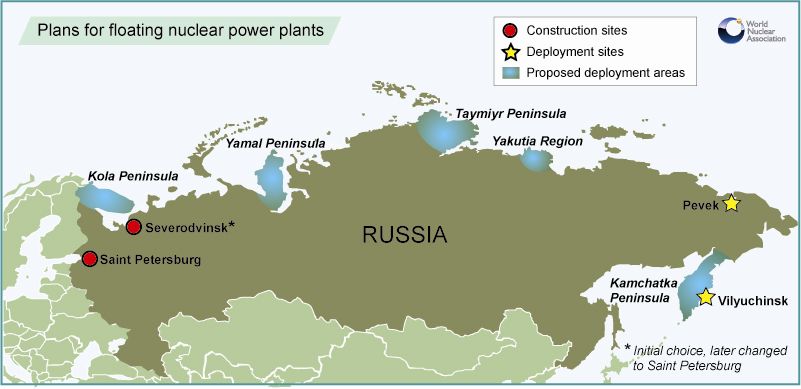Russia and China have held their first meeting for cooperation in the development of marine nuclear energy for floating power plants and potentially for propulsion of large ships.
While hundreds of nuclear reactors have been employed in the military navies of China, France, Russia, the UK and USA for decades, only Russia has maintained a fleet of civil nuclear ships: the icebreakers that work the country's Arctic ports and one freighter. Other countries' forays into civil marine nuclear power - the NS Savannah, the Otto Hahn and the Mutsu - did not continue in the long term due to various social, economic or technical factors.
Russia went on to expand its leadership in this area with the adaptation of the KLT-40S small reactor for installation in pairs on a barge. This vessel could be docked in remote places to supply power and heat either to the local population or new industry. The first such floating nuclear power plant, the Akademic Lomonosov, is at an advanced stage of construction at the Baltiysky Zavod shipyard. The barge is completed and afloat, with main power systems already fitted. Eventually it will be maneuvered along rivers and canals to the Arctic sea and towed to the town of Vilyuchinsk on the Pacific coast of Kamchatka Peninsula in Russia's far east. Another is planned for Pevek, on the Arctic coast.
 |
| Potential deployment sites for nuclear power barges. China has yet to name any sites |
Chinese interest in this kind of power source has grown steadily in recent years and has now reached the level of formal cooperation. The first meeting for this was held at the end of November in Chengdu, Sichuan province. Around the table were representatives of power plant operator Rosenergoatom, designer OKBM Afrikantov as well as China National Nuclear Corporation (CNNC) and its subsidiary the Nuclear Power Institute of China.
Rosenergoatom reported a 'high degree' of interest from the Chinese side, 'with a view to joint development of design solutions for the construction of floating nuclear power plants in China and joint promotion of projects in third countries.'
| European vacation
Early next year the 50 Years of Victory will be temporarily redeployed from Arctic duties to maintain shipping lanes in the Gulf of Finland. This eastern portion of the Baltic Sea often freezes over completely and last year the major port at Saint Petersburg suffered congestion after a lack of icebreaking capacity. The nuclear ship will join six diesel-powered icebreakers based in the port.
|
The bilateral cooperation group talked about the possible direction it could take. China is primarily interested in deploying floating nuclear power platforms for oil and gas installations at sea, and for the service of remote communities. Another application under consideration in Beijing is the propulsion of large cargo ships, for example on point-to-point routes carrying heavy cargo like mineral ore.
Based on the status of the Akademik Lomonosov, Rosenergoatom said it had at its disposal 'a full package of design documents to create a reference floating nuclear power plant for China'.
China has given a set of proposals to Russia for consideration as dialogue continues ahead of the next formal meeting in May 2012. Separately the countries are discussing cooperation for space nuclear power systems, and from mid-2012 Russia will supply radioisotope thermal generators to the Chinese space program.
In more conventional nuclear power, Russia has already built the two-unit Tianwan nuclear power plant in Jiangsu province, where two more are expected to be fully contracted soon. OKBM led the construction of the 65 MWt China Experimental Fast Reactor near Beijing, and a 1000 MWe power-generating version is slated to begin construction in 2017 known as the China Demonstration Fast Reactor. Before that, however, could come two BN-800 fast-reactor units also by OKBM at Sanming, on which construction could start in 2013.
Researched and written
by World Nuclear News




_82983.jpg)
_34792.jpg)
_16403_79272.jpg)
_44458.jpg)

_76087_55556.jpg)



